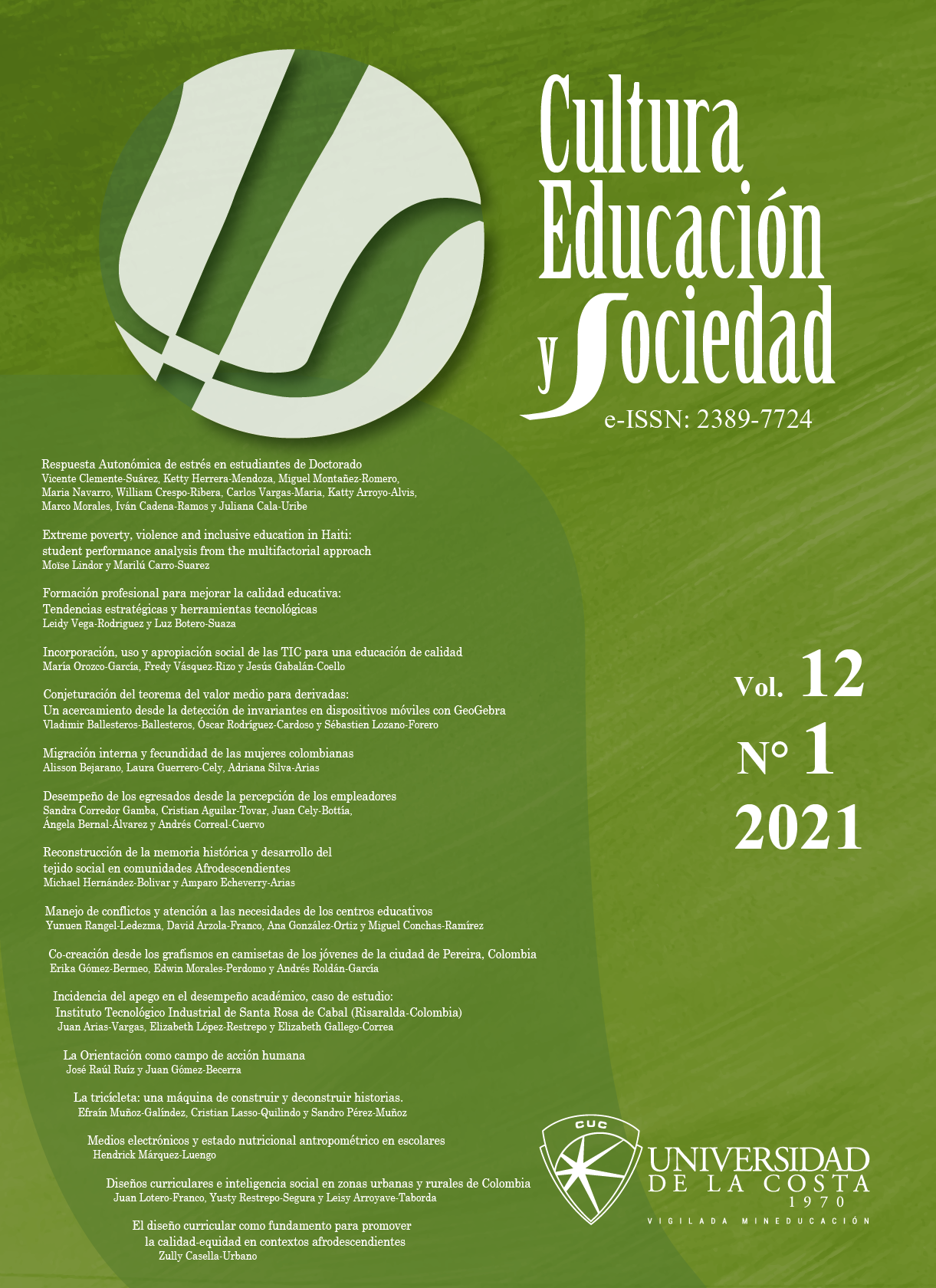Extreme poverty, violence and inclusive education in Haiti: Student performance analysis from the multifactorial approach
DOI:
https://doi.org/10.17981/cultedusoc.12.1.2021.02Keywords:
Violence, Education, Extreme poverty, School dropout, Perception of fearAbstract
The objective of this work is to analyze the impact of violence, crime, kidnapping and extreme poverty on the academic performance and mental health of high school and undergraduate students in public schools and colleges located in Port-au-Prince (Haiti). It is a qualitative research of a deductive type and a semi-structured interview to collect the data and draw the pertinent conclusions. The results show a proportion of undergraduate students in very difficult socioeconomic situations, and with fear of being kidnapped when going to school, due to violent acts. Likewise, high school students have expressed their fear of being violated, which causes various psychological disorders. It was concluded that poverty and violent events harm inclusive and continuous education, school performance, collective well-being and the tranquility of students, and the general population.
Downloads
References
Castillero, M. O. (March 8, 2017). What is social violence? In Psychology and mind. [Online]. Available: https://psicologiaymente.com/social/violencia-social#:~:text=Violencia%20social%3A%20%C2%BFqu%C3%A9%20es%3F,o%20por%20la%20propia%20comunidad
Dávila, N. G. (2006). Inductive and deductive reasoning within the research process in experimental and social sciences. Laurus, 12(1), 180–205. Available: https://biblat.unam.mx/es/revista/laurus
Echeburúa, E. (2019). Violence and mental disorders. A complex relationship. Neurology journal, 69(11), 69–472. https://doi.org/10.33588/rn.6911.2019424
ECLAC. (2013). Social protection systems in Latin America and the Caribbean: Haiti. [Online]. Available: https://www.cepal.org/es/publicaciones/4050-sistemas-proteccionsocial-america-latina-caribe-haiti
Educational Trends Information System in Latin America. (2005). Trends in the relationship between education and unemployment in Latin America. [Online]. Available: http://archivo.siteal.iipe.unesco.org/sites/default/files/tendencias_educacion_desempleo.pdf
Espín, J. C., Valladares, A. M., Abad, J. C., Presno, C. & Gener, N. (2008). Violence, a health problem. Cuban Journal of Comprehensive General Medicine, 24(4), 1–6. Available: http://scielo.sld.cu/scielo.php?script=sci_arttext&pid=S0864-21252008000400009
Feijoó, M. & Corbetta, S. (2004). School and poverty: educational challenges in two scenarios in Greater Buenos Aires [Argentina]. [Online]. Buenos Aires: IIPE-UNESCO. Available: https://unesdoc.unesco.org/ark:/48223/pf0000142343
Gamboa, A. (november 27, 2012). Brain drain grows in poor countries. [Online]. Available in: https://aldianews.com/es/articles/politics/crece-fuga-de-cerebros-en-pa%C3%ADsespobres/30058
García, T. (2003). The questionnaire as a research/evaluation tool. [Online]. Available in: http://www.univsantana.com/sociologia/El_Cuestionario.pdf
Garmendia, L. F. (2011). Violence in Latin America. Annals of the Faculty of Medicine, 72(4), 269–276. https://doi.org/10.15381/anales.v72i4.1081
González, E. G., Pardo, M. E. & Izquierdo, J. M. (2017). Violence as a public health problem in Venezuela: some reflections from the perspective of the citizen security professional. Medisan, 21(5), 642–648. Available: http://scielo.sld.cu/pdf/san/v21n5/san20215.pdf
IHSI. (2001). Survey on Living Conditions in Haiti 2001. ECVH, 2001. [Online]. Available: https://catalog.ihsn.org/index.php/catalog/4320
López, N. (2003). What’s new, man? [Document for discussion]. Buenos Aires: Mimeo.
López, J. L. (2001). Scientific Methods and Hypothesis. México, D.F.: Trillas.
López-Roldan, P. & Fachelli, S. (2015). Social research methodology Quantitative. Barcelona: Universitat Autònoma de Barcelona. Available: https://ddd.uab.cat/pub/caplli/2016/163567/metinvsoccua_a2016_cap2-3.pdf
Maya, E. (2014). Research methods and techniques. An agile proposal for presentation scientific work in the areas of architecture, urban planning and related disciplines. Ciudad de México: UNAM. Mexico.
Muñoz, V. (2014). The Human Right to Education. Sinéctica Electronic journal of education, 42(1), 1–10. Available: https://sinectica.iteso.mx/index.php/SINECTICA/article/view/67/59
Narro, J., Martuscelli, J. & Barzana, E. (Coord.) (2012). Ten-year plan to develop the National Education System. [Online]. México, D.F.: UNAM. Available: http://www.planeducativonacional.unam.mx
Ortiz, F. X. (january 29, 2015). The importance of education in Mexico. Practice. [Online]. Available: https://www.gestiopolis.com/la-importancia-de-la-educacion-en-mexico-ensayo/2
Robles, A. L. (2014). Fear in the streets: the main thrill of public criminal insecurity. A criminological and gender study. Journal of the Institute of Legal Sciences of Puebla, 8(34), 81–100. http://dx.doi.org/10.35487/RIUS.V8I34.2014.123
Plazaola-Castaño, J. & Ruíz, I. (2004). Violence against women in the couple and consequences on physical and mental health. Clinical Medicine, 122(12), 461–467. https://doi.org/10.1016/S0025-7753(04)74273-6
Sánchez, C. J. (2016). Insecurity and unemployment. Population and Development Magazine, 29(16), 94–106. Available: https://dialnet.unirioja.es/descarga/articulo/5654297.pdf
Sánchez, R. A. (2015). Student’s T. Uses and abuses. Mexican cadiology magazine, 26(1), México, D.F. Available: https://www.medigraphic.com/cgi-bin/new/resumen.cgi?IDARTICULO=56921
Sarabia, S. (2018). Violence: a public health priority. Journal of Neuro-Psychiatry, 81(1), 1–8. http://dx.doi.org/https://doi.org/10.20453/rnp.v81i1.3267
Schenone, M. & Narodowski, M. (2018). The educability in the educational agenda. A Hybrid Method. [Online]. Available: https://www.researchgate.net/publication/327189371_LA_EDUCABILIDAD_en_la_agenda_educativa_Un_Metodo_hibrido
UN. (2016). Ending poverty. [Online].Available: https://www.un.org/es/sections/issuesdepth/poverty/index.html
UN. (2013). Peace and Security. [Online]. Available: https://www.un.org/es/sections/issues-depth/peace-and-security/index.html
UN. UNDP. (2013). Human Development Report for Latin America 2013-2014. [Online]. Available: https://www.latinamerica.undp.org/content/rblac/en/home/library/human_development/informe-regionalde-desarrollo-humano2013-2014-.html
UNESCO. (october 10, 2018). What you need to know about the right to education. [Online]. Available: https://en.unesco.org/news/what-you-need-know-about-right-education
UNESCO. (2016). Education Policies Recommendations in Latin America based on Terce. [Online]. Santiago de Chile: OREALC/UNESCO. Available: http://www.unesco.org/new/fileadmin/MULTIMEDIA/FIELD/Santiago/pdf/Education-Policies-Recommendations.pdf
UNICEF. (2010). Children in Haiti. Achievements and perspectives six months after the Earthquake. [Online]. Available: https://www.unicef.org/Infancia_en_Haiti-_6_meses_despues.pdf
Vinces, E. (2006). Violence and mental illness. Spanish Journal of Penitentiary Health, 8(3), 95–99. Available: http://www.sanipe.es/OJS/index.php/RESP/article/view/119/279
Vidal, F. (2008). The new accelerators of remoderned violence. In: A. Garcia-Mina (Coord.), New scenarios of violence. Reflections Quotes Social Sciences I (pp. 17–46). Madrid: Universidad Pontificia Comillas de Madrid.
WHO. (2013). Global and regional estimates of violence against women: prevalence and health effects of intimate partner violence and non-partner sexual violence. Ginebra: WHO. Available: http://www.who.int/reproductivehealth/publications/violence/9789241564625/en/
Published
How to Cite
Issue
Section
License
Copyright (c) 2020 CULTURA EDUCACIÓN Y SOCIEDAD

This work is licensed under a Creative Commons Attribution-NonCommercial-NoDerivatives 4.0 International License.
![]()
Creative Commons 2020 CULTURA EDUCACIÓN Y SOCIEDAD
This article is under international license Creative Commons Reconocimiento-NoComercial-SinObrasDerivadas 4.0.
The published articles are the sole responsibility of their authors and do not necessarily reflect the opinions of the editorial committee.
CULTURA EDUCACIÓN Y SOCIEDAD respects the moral rights of its authors, who assign to the editorial committee the patrimonial rights of the published material. In turn, the authors inform that this work is unpublished and has not been previously published.
All articles are under a:
Licencia Creative Commons Atribución-NoComercial-SinDerivadas 4.0 Internacional.
![]()


 English
English
 Español (España)
Español (España)




_12.53_.27_p_. m_._3.png)





_12.57_.35_p_. m_._3.png)
_12.50_.37_p_. m_._3.png)



